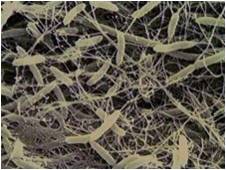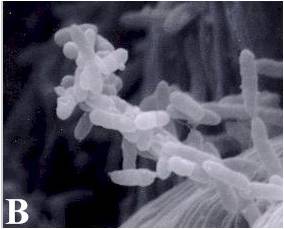Acetobacter aceti: Difference between revisions
(Created page with "{{Uncurated}} {{Biorealm Genus}} ==Classification== ===Higher order taxa=== gjglj domain; phylum; class; order; family; [Others may be used. Use NCBI link to find] ===Species...") |
|||
| (41 intermediate revisions by 2 users not shown) | |||
| Line 1: | Line 1: | ||
{{Uncurated}} | {{Uncurated}} | ||
{{Biorealm Genus}} | {{Biorealm Genus}} | ||
''Acetobacter aceti'' | |||
==Classification== | ==Classification== | ||
[[Image:Acetobacter aceti.jpg|frame|right|150px|Scanning electron Micrograph of ''Acetobacter aceti'' is shown above (1)]] | |||
===Higher order taxa=== | ===Higher order taxa=== | ||
Bacteria; [http://en.wikipedia.org/wiki/Proteobacteria Proteobacteria]; AlphaProteobacteria; Rhodospirillales; Acetobacteraceae | |||
===Species=== | ===Species=== | ||
'' | ''[http://en.wikipedia.org/wiki/Acetobacter Acetobacter] aceti; Acetobacter calcoaceticus; Acetobacter cerevisiae; Acetobacter cibinongensis; Acetobacter diazotrophicus; Acetobacter estunensis; Acetobacter indonesiensis; Acetobacter lovaniensis; Acetobacter malorum; Acetobacter orientalis; Acetobacter orleanensis; Acetobacter pasteurianus; Acetobacter peroxydans; Acetobacter polyoxogenes; Acetobacter pomorum; Acetobacter subgen. Acetobacter aceti; Acetobacter syzygii; and Acetobacter tropicali.'' | ||
==Description and significance== | ==Description and significance== | ||
[[Image:Acetobacter_aceti_flagella.jpg|frame|right|150px|Scanning electron Micrograph of ''Acetobacter aceti'' with peritrichous flagella is shown above]] | |||
''Acetobacter aceti'' is a non-pathogenic, [http://en.wikipedia.org/wiki/Gram_negative gram negative] prokaryote that converts ethanol to acetic acid with the presence of oxygen, making it an [http://en.wikipedia.org/wiki/Obligate_aerobe obligate aerobe]. This microbe is commonly known to the public as producing vinegar, wines, and beers. ''Acetobacter aceti'' is an aerobe and is also motile via peritrichous flagella. ''Acetobacter aceti'' is ubiquitous in nature and is everywhere there is fermentation occurring, growing optimally in a seven percent ethanol solution at thirty degrees Celcius. ''Acetobacter aceti'' is also known for its high tolerance of acidic conditions.(1,4) | |||
==Genome structure== | ==Genome structure== | ||
There are 3,340,429 total base pairs of [http://en.wikipedia.org/wiki/DNA DNA] that make up the genome of ''Acetobacter aceti''. There are a total of 3122 genes within ''Acetobacter aceti''. 3050, or ninety seven percent of the [http://en.wikipedia.org/wiki/Genes genes] all code for proteins, meaning that a large portion of ''Acetobacter aceti'' is to produce protein.(4) | |||
==Cell and colony structure== | ==Cell and colony structure== | ||
''Acetobacter aceti'' are [http://en.wikipedia.org/wiki/Rod-shaped rod shaped] cells and can occur as individual cell pairs, chains, and small clusters units. The flagellum of ''Acetobacter aceti'' is arranged peritrichously. The cells can rotate their [http://en.wikipedia.org/wiki/Flagellum flagellum] counter clockwise and clockwise in direction.(4) | |||
==Metabolism== | ==Metabolism== | ||
''Acetobacter aceti'' is an obligatory aerobic bacterium that can fix nitrogen during its metabolic processes and is known for producing [http://en.wikipedia.org/wiki/Alcohol alcohol] as a byproduct of its metabolism. ''Acetobacter aceti'' uses sugars and alcohols for its carbon source and turns them into their acetic acid. The external electron source is nitrogen in the form of nitrite and nitrate and reduces them into ammonia and hydrogen. The primary molecule ''Acetobacter aceti'' produces is [http://en.wikipedia.org/wiki/Acetic_acid acetic acid].(2,3,4) | |||
==Ecology== | ==Ecology== | ||
[[Image:Acetobacter_aceti_clump.jpg|frame|right|150px|Scanning electron Micrograph of ''Acetobacter aceti'' is shown above]] | |||
''Acetobacter aceti'' is widespread in the environment; living in any environment where there is sugar present. This environment includes flowers, fruits, soil, and water. ''Acetobacter aceti'' contributes to the environment in many ways, metabolizing and breaking down foods such as fruits so that other animals can feed off its wastes and metabolize its byproducts. ''Acetobacter aceti'' has been utilized for the specifics of metabolizing sugars and releases its byproducts in the form of acetic acid, producing [http://en.wikipedia.org/wiki/Vinegar vinegar], a food product for us as humans to consume.(2,4) | |||
==Pathology== | ==Pathology== | ||
''Acetobacter aceti'' has yet to be reported as a pathogenic microbe to humans or animals. ''Acetobacter aceti'' does not produce any toxins, enzymes, or any viruses that harm any human or animal. Since ''Acetobacter aceti'' is ubiquitous in nature and there is contact of this bacterium on all animals on a frequent basis. ''Acetobacter aceti'' is not a portion of normal flora of bacteria on human skin. The only potential pathology it could present is if presented in mass quantities, an [http://en.wikipedia.org/wiki/Allergic_response allergic or immune response] could occur. ''Acetobacter aceti'' does produce alcohols, meaning if consumed in large quantities, these alcohols could affect the central nervous system, causing intoxication via alcohol, a byproduct of ''Acetobacter aceti'', although alcoholism or intoxication is not due to the bacterium. ''Acetobacter aceti'' is known to cause rotting and browning discoloration in fruits such as apples, pears, and citrus products. Acetobacter aceti is known for causing pink disease in pineapple, which is the turning of the pineapple pink due to the metabolism of the pineapple by ''Acetobacter aceti'' along with the production of its waste.(4) | |||
==References== | ==References== | ||
[http:// | [http://jb.asm.org/content/187/13/4346.full 1] J. Bacteriol. Acetobacter aceti Possesses a Proton Motive Force-Dependent Efflux System for Acetic Acid Journal of Bacteriology. July 2005 vol. 187no. 13 4346-4352. DOI: 10.1128/JB.187.13.4346-4352.2005. | ||
[http://jb.asm.org/content/187/13/4346.short 2] A Specialized Citric Acid Cycle Requiring Succinyl-Coenzyme A (CoA):Acetate CoA-Transferase (AarC) Confers Acetic Acid Resistance on the Acidophile Acetobacter acetiJ. Bacteriol. July 2008 190:4933-4940. DOI: 10.1128/AEM.72.1.497-505.2006. | |||
[http://www.google.com/urlsa=t&rct=j&q=&esrc=s&source=web&cd=1&ved=0CCMQFjAA&url=http%3A%2F%2Fwww.jbc.org%2Fcontent%2F286%2F13%2F11163.full&ei=fLaiT--HN8rH6AHq-JTGCA&usg=AFQjCNE0c3smeLANV2Jr9DEVU357DsBPjQ 3]Lantibiotic Transporter Requires Cooperative Functioning of the Peptidase Domain and the ATP Binding DomainJ. Biol. Chem. April 2011 286:11163-11169. DOI: 10.1074/jbc.M110.212704 | |||
[http://en.wikipedia.org/wiki/Acetobacter 4] http://en.wikipedia.org/wiki/Acetobacter | |||
No DOI | |||
Edited by | Edited by David Morin of Dr. Lisa R. Moore, University of Southern Maine, Department of Biological Sciences, http://www.usm.maine.edu/bio | ||
Latest revision as of 01:31, 16 May 2012
A Microbial Biorealm page on the genus Acetobacter aceti
Acetobacter aceti
Classification
Higher order taxa
Bacteria; Proteobacteria; AlphaProteobacteria; Rhodospirillales; Acetobacteraceae
Species
Acetobacter aceti; Acetobacter calcoaceticus; Acetobacter cerevisiae; Acetobacter cibinongensis; Acetobacter diazotrophicus; Acetobacter estunensis; Acetobacter indonesiensis; Acetobacter lovaniensis; Acetobacter malorum; Acetobacter orientalis; Acetobacter orleanensis; Acetobacter pasteurianus; Acetobacter peroxydans; Acetobacter polyoxogenes; Acetobacter pomorum; Acetobacter subgen. Acetobacter aceti; Acetobacter syzygii; and Acetobacter tropicali.
Description and significance
Acetobacter aceti is a non-pathogenic, gram negative prokaryote that converts ethanol to acetic acid with the presence of oxygen, making it an obligate aerobe. This microbe is commonly known to the public as producing vinegar, wines, and beers. Acetobacter aceti is an aerobe and is also motile via peritrichous flagella. Acetobacter aceti is ubiquitous in nature and is everywhere there is fermentation occurring, growing optimally in a seven percent ethanol solution at thirty degrees Celcius. Acetobacter aceti is also known for its high tolerance of acidic conditions.(1,4)
Genome structure
There are 3,340,429 total base pairs of DNA that make up the genome of Acetobacter aceti. There are a total of 3122 genes within Acetobacter aceti. 3050, or ninety seven percent of the genes all code for proteins, meaning that a large portion of Acetobacter aceti is to produce protein.(4)
Cell and colony structure
Acetobacter aceti are rod shaped cells and can occur as individual cell pairs, chains, and small clusters units. The flagellum of Acetobacter aceti is arranged peritrichously. The cells can rotate their flagellum counter clockwise and clockwise in direction.(4)
Metabolism
Acetobacter aceti is an obligatory aerobic bacterium that can fix nitrogen during its metabolic processes and is known for producing alcohol as a byproduct of its metabolism. Acetobacter aceti uses sugars and alcohols for its carbon source and turns them into their acetic acid. The external electron source is nitrogen in the form of nitrite and nitrate and reduces them into ammonia and hydrogen. The primary molecule Acetobacter aceti produces is acetic acid.(2,3,4)
Ecology
Acetobacter aceti is widespread in the environment; living in any environment where there is sugar present. This environment includes flowers, fruits, soil, and water. Acetobacter aceti contributes to the environment in many ways, metabolizing and breaking down foods such as fruits so that other animals can feed off its wastes and metabolize its byproducts. Acetobacter aceti has been utilized for the specifics of metabolizing sugars and releases its byproducts in the form of acetic acid, producing vinegar, a food product for us as humans to consume.(2,4)
Pathology
Acetobacter aceti has yet to be reported as a pathogenic microbe to humans or animals. Acetobacter aceti does not produce any toxins, enzymes, or any viruses that harm any human or animal. Since Acetobacter aceti is ubiquitous in nature and there is contact of this bacterium on all animals on a frequent basis. Acetobacter aceti is not a portion of normal flora of bacteria on human skin. The only potential pathology it could present is if presented in mass quantities, an allergic or immune response could occur. Acetobacter aceti does produce alcohols, meaning if consumed in large quantities, these alcohols could affect the central nervous system, causing intoxication via alcohol, a byproduct of Acetobacter aceti, although alcoholism or intoxication is not due to the bacterium. Acetobacter aceti is known to cause rotting and browning discoloration in fruits such as apples, pears, and citrus products. Acetobacter aceti is known for causing pink disease in pineapple, which is the turning of the pineapple pink due to the metabolism of the pineapple by Acetobacter aceti along with the production of its waste.(4)
References
1 J. Bacteriol. Acetobacter aceti Possesses a Proton Motive Force-Dependent Efflux System for Acetic Acid Journal of Bacteriology. July 2005 vol. 187no. 13 4346-4352. DOI: 10.1128/JB.187.13.4346-4352.2005.
2 A Specialized Citric Acid Cycle Requiring Succinyl-Coenzyme A (CoA):Acetate CoA-Transferase (AarC) Confers Acetic Acid Resistance on the Acidophile Acetobacter acetiJ. Bacteriol. July 2008 190:4933-4940. DOI: 10.1128/AEM.72.1.497-505.2006.
3Lantibiotic Transporter Requires Cooperative Functioning of the Peptidase Domain and the ATP Binding DomainJ. Biol. Chem. April 2011 286:11163-11169. DOI: 10.1074/jbc.M110.212704
4 http://en.wikipedia.org/wiki/Acetobacter No DOI
Edited by David Morin of Dr. Lisa R. Moore, University of Southern Maine, Department of Biological Sciences, http://www.usm.maine.edu/bio



